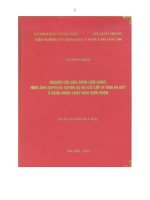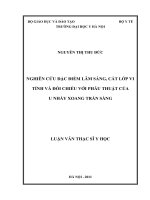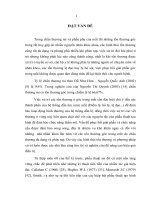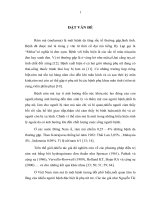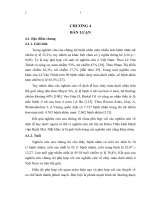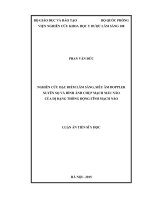Nghiên cứu đặc điểm lâm sàng, nồng độ nọc trong máu và giá trị của xét nghiệm nhanh trong chẩn đoán và điều trị bệnh nhân bị rắn hổ mang cắn tt tiếng anh
Bạn đang xem bản rút gọn của tài liệu. Xem và tải ngay bản đầy đủ của tài liệu tại đây (353.64 KB, 14 trang )
THIS ST UDY WAS COMPLETED
AT THE INST ITUTE FOR SCIENTIFIC RESEARCH
MINISTRY OF TRAINING & EDUCATION
MINIST RY OF DEFENCE
ON CLINICAL MEDICINE AND PHARMACY 108
INS TITU TE FO R SC IENTIFIC RES EARCH
ON C LINIC AL MEDICINE AND PHARMACY 108
Scientific instructors:
1. Associate prof. Pham Due, PhD
2. Dr. To Vu Khuong, PhD
NGUYEN TRUN G NGUYEN
Scientific critic 1: ……………………………………………
Scientific critic 2: ……………………………………………
CLINICAL FEATURES,
BLOOD VENOM LEVELS
AND THE ROLE OF COBRA RAPID TEST®
IN THE DIAGNOSIS AND TREATMENT OF
COBRA BITTEN PATIENTS
Expe rtise: Anaesthesia & Inte nsive care
Code: 62720122
Scientific critic 3: ……………………………………………
This thesis is planned to be defended before institutional thesis
evaluation board at:
time
day
month
year
The thesis can be assessed at:
1. National library
2. The library of the Institute for scientific research on
clinical medicine and pharmacy 108
ABS TRACT OF DOCTORAL THES IS
HANOI - 2019
INTRODUCTION
CHAPTER 1
OVERVIEW
Snakebite is a common emergency condition. It has been inc luded
in the list of neglected tropical diseases requiring adequate attention.
Cobra bite is the most frequent in the snakebite cases and causes many
types of injuries, demands emergency hospita l admission and has high
risk of death, longterm sequalae or disability.
There have been certain studies on snakebite in V ietnam.
However, no study focusing on cobra bite spcifying the exposure factors,
clinical and laboratory features of the evenomation, especially the
evaluation on the relationships between these parameters and blood
venom levels in all patients, has been carried out.
The currently known 61 species of venomous snakes have
overlapping evenomation clinical conditions challenging the diagnosis
approach by syndromes, leading to delayed, incorrect or missed
diagnosis and affecting emergency management. A rapid cobra venom
test is thefore very necessary to be available to assist the diagnosis and
treatment.
The specific treatment with snake antivenom f or the neutralization
of venom is the optimal solution. There has been only a monovalent
cobra antivenom (made from the venom of Naja kaouthia in the South of
Vietnam) so far in the country for the treatment of evenomation by cobra
species. There have been also no studies on the evaluation of the protocol
and effectiveness of this antivenom on the evenomation by cobra species
in the North of Vietnan.
This study is aimed at:
1. Specifying c linical fearures, blood venom levels in the cobra
bitten patients treated at the Poison control center of Bach Mai hospita l.
2. Eva luating the value of Cobra Rapid Test in the diagnosis
and treatment w ith antive nom in patients with cobrabite.
1.1. Cobra:
1.1.1. Epide miology:
According to an evaluation on the global snakebite burden,
Vietnam belongs to one of 21 areas with the highest number of snakebite
victims and one of 4 zones with the highest death rate.
Researches and reports from Bach Mai hosita l and Cho Ray
hospital show that snakebite is a common emergency in which cobrabite
is the highest.
1.1.2. Naja genus:
a. In the world:
There have been totally 26 species of cobra identified so far
inc luding 11 species in Asia and 15 others in Africa.
b. In Vietnam: N. atra (Cantor, 1842): “rắn hổ mang miền Bắc”,
in V ietnamese. Distribution: widely distributed in the North of V ietnam.
N. kaouthia (Lesson, 1831): in Vietnamese, “rắn hổ đất”. Distribution:
widely distributed in the South of Vietnam. N. siamensis (Laurenti,
1768): in V ietnamese, “rắn hổ mèo”, only distributed in the South.
1.2. Disgnosis and treatment of cobrabite:
1.2.1. Signs and symptoms:
a. Snakebite by N. atra, N.kaouthia:
- Local: there is ussually mechanical injury at the bitten site.
Redness, swelling, necrosis, vesicles may occur and progress gradually.
Local lymphatic nodes can enlarge.
- Systematic: paralysis may occur, flaccid paralysis beginning at
cranial nerves and decending to limbs. Paralysis may lead to respiratory
failure and death if untreated. Other signs and symptoms can exist:
abdominal pa in, nausea and vomitting, diarrhea, rhabomyolysis, renal
failure.
b. Snakebite by N. siamensis:
Signs and symptoms are similar to the conditions caused by the 2
above 2 mentioned sepcies but more frequent and severe. Paralysis has
not been seen.
1.2.2. Complications of snakebite: respiratory failure , infection,
renal failure, compartment syndrome, scar, amputation, disability,...
1.2.3.Diagnosis of s nake bite:
1.2.3.1. Diagnosis of s pecific snake species:
a. Syndrome approach: practical, symple, rapid and must be
applied from the beginning but difficult to identify specific species.
b. Identification of culprit snake: common and gold standard.
c. Immunologic tests:
Rapid test kits: there have been rapid tests in the world but very
few have been commercially available.
Immunochromatographic rapid test for cobra venom:
The test kit Cobra Rapid Test (CRT ®) develope d by D.Z.Hung et
al (2005) for the dia gnosis of snakebite by N. atra in Ta iwan,
detection threshold for the blood cobra venom is 5ng/ml. Test is
performe d by dropping plasma, urine or fluid from bitten site on the
test kit. The result is observe d after 20 minutes with the sensitivity of
88% and spec ificity of 100%.
Qualification and quantification of ve nom with Enzyme
linked immunosorbe nt assay (ELISA):
Patient sample is incubated with anti-snake venom specific
antibody which is to be analyzed, the incubated environment w ill change
the color when the antibody combines with the antigen. The intensity of
the color is equivalent to the venom concentration in the sample.
Detection threshold is from 1 to 5ng/ml and performing duration is
within 3 hours.
d. Ide ntification of snake species with gene analysis.
1.2.3.2. Diagnosis of severity of the snakebite:
Common classification of poisoning severity - Poisoning
Severity Score (PSS): recommended by the Wold Health Organization.
Classification of poisoning severity specicially for snake bite:
The classicication help the direction of management, especially for the
use of antivenom and monitoring the patients’ condition. There have
been classification of snakebite severity commonly applied for cobrabite
in V ietnam and the world.
1.2.4. Management of s nake bite:
1.2.4.1. Antivenom the rapy:
Evidence has shown that antivenom therapy can prevent toxic
effects of the venom if it is used early and can limit these effects even if
used when clinical condition became clear.
Indication of antivenom therapy by the WHO: it is appled for all
snakebites. This guideline, however, does not mention the necrosis, the
cause of severe outcomes and sequalae for the patients. Therefore this
issue needs to be studied.
Specific situdies on the use of cobra antivenom are required in
Vietnam so that results of treatment can be improved.
1.2.4.2. Supportive care , tre atme nt of symptoms and
complications.
1.3. Studies in Vie tnam and the world:
The definitive diagnosis of snakebite by a specific species: this is a
gold criteria but researches have not been carried out adequately.
There have been at least 61 identified species of venomous snakes
with overlapping evenoming conditions challenging clinical approach.
There needs to be other diagnostic methods, e.g. immunologic
techniques.
There have been very few studies on the necrosis. Moreover,
documents states that this injury does not respond to antivenom.
Clinical researches usually lack blood venom leve l as a eveluation
tool. Whereas blood venom levels help the identification of culprit snake
species, progress of evenomation, risk factors, degrees of evenomation
and effectiveness of first aids and treatment in the hospital including
antivenom therapy.
Rapid tests for snake venoms have been use to support the
indication of antivenom only and the nonitoring of the patients’
conditions rely totally on clinical situation which may make clinical
doctors meet difficult.
CHAPTER 2
RESEARCH METHOD
2.1. Patie nts:
Inclusion criteria:
All snakebite patients were admitted to the Poison control center
of Bach Mai hospital from 01/01/2013 to 31/12/2015 and fullfilled the
both following criteria:
1) Patients give the samples or photographs of the culprit snakes to
the doctors at the Poison center for the identification of snake species by
morphology analysis (the photographs need to bee clear, the posteria
views of the hoods must be available if it is the case of cobrabite. 2)
Antivenom has noot been used before arrival.
2.2. Research me thod:
- This is a prospective and descritiptive study.
2.2.1.Sample size :
Evaluation of the CRT on cobrabite patie nts:
The main purpose of this study is to evaluate the sensitivity of the
rapid test CRT is calculated by the rate (%) of the number of patients
with positive results over total number of the patients diagnosed
definitively with cobrabite.
Estimate n with the formula: n =
TP: true possitive
FN: false negative
Calculate TP + FN:
TP+FN =
Z2 : constant of normal distribution, with α = 0,05, Z 2 = 1,96
SN: minimal sensitivity, 75% (0,75), W : odd of the probability
of true positive results and probability of true negative results,
select w = 0,1
Therefore: TP + FN = (1,96 x 0,75 x 0,25)/ (0,1 x 0,1) = 36,75
Based on the numbers of snakebite patients admitted to the
Poison center, the minimal of cobrabite is 33%.
So n = 36,75/0,33 = 111,36. We select that n =112
2.2.2. Research paramete rs:
2.2.2.1. Demographic data:
Age, gender, occupation, geographic information.
2.2.2.2. Clinical, laboratory fe atures and blood venom levels:
a. Clinical condition:
Situation of accident, characteristics of culprit snake, reason for
accident, applied firstaids, treatment at previous hospitals.
Signs, symptoms. Local: pain score, swelling, incomleted and
completed necrosis, erytherma, vesicles, local enlarged lymphatic nodes,
compartment syndrome. Systemic : abdominal pain, nausea and
vomitting, diarrhea, pulse rate, cardiac rythms, blood pressure, body
temperature, paralysis, respiratory fa ilure.
b. Laboratory tests:
Blood count, coagulation tests, urea, creatinine, glucose,
electrolytes, GOT, GPT, CPK, procalcitonin.
Results of CRT: blood, fluid of fang marks, urine.
Results of ELISA: blood venom levels on admission and after
antivenom.
c.Evaluation of evenomation severity:
Classification according to PSS.
Proposed classification of severity in this study and research
protocol for the use of antivenom: compatibility between the research
classification of severity and PSS.
d. Exploration of re lationships among risk factors, severity
and tre atment:
Relationships among evenomation severity, exposure factors and
treatment.
First aids applied prehospita lly and local tissue injuries.
Blood venom levels, results of blood CRT and exposure factors,
severity and treatment.
2.2.2.3.
The role of CRT in the diagnosis and monitoring of
treame nt:
a. In the diagnosis:
- Sensitivity and specific ity of CRT, negative predictive value,
positive predictive value, rates of false negative and false positive results.
b. In the monitoring and evaluation of treatment:
CRT:
- Negative or positive results are compared with the severity,
loca l tissue injuries, methods of first aids already applied prehospitally.
- Evaluation of 2 protocols for the monitoring of antivenom
therapy: group w ith the combination of clinical condition and blood CRT
or group w ith only c linical condition are compared on the local tissue
injuries, total dose of antivenom, duration of antivenom therapy,
hospitalization time.
ELISA (blood venom levels): used to evaluate the effectiveness
of the first aids, treatment measures and outcomes.
c.Treatment outcomes:
Change in the local tissue injuries, total dose and duration of
antivenom therapy, complications, bedtime, final treatment results.
2.2.3. Evaluation tools:
2.2.3.1. Clinical evaluation tools:
Patient records: history, physical exams, laboratory tests,
treatment measures and results. Tools for the assessment of cobrabite
injuries: pain scales, tape measure: circumference measured across bitten
site, extension of swelling, transparent square ruler on which one unit
equals to 1cm2 , permanent marker.
2.2.3.2. Laboratory tests and imaging:
a. Routine laboratory tests: blood cell ana lyzers, biochemical
analyzer. Electrocardiographer, dopper ultrasound for the blood flows to
bitten areas.
b. CRT and quantitative ELISA of blood cobra venom:
CRT:
Sample : blood (for a ll pa tients on a dmission, before and
ntive nom thera py, after a ntive nom for the group used CRT to
combined with c linical c ondition): 3ml of blood is drawe d to the
unc oagula te d tube , centrifuged to collect plasma. Fluid from bitten
site a nd urine are a lso c olle cte d.
Research condition:
+ CRT test strip was supplied by the Taiwan colleagues according
to the co-operative program between the 2 sides. The number of CRT
was limited initially because it was planned to be evaluated the
diagnostic role. The CRT thereafter shown advantages when studied so
the study group required additional number of CRT to support the
monitoring and decision of the completion of antivenom therapy.
The study was devided in to 2 phases:
The first phase when the test strip was not added: completion of
antivenom was decided based on the resolution of clinical condition.
The second phase when the CRT was added: the completion of
antivenom was decided based on the combination of negative repeated blood
CRT and resolution of clinical condition.
ELISA (enzyme linked immunosorbent assay) to detect the
venom of N. atra:
- Blood samples taken on admission, before and after antivenom
therapy. Venom of Vietnam N. Atra, anti-cobra venom antibody
produced from rabbits by the Faculty of Immunology of the Academy of
Military Medicine and other materials.
- ELISA microplate reader: produced by Diagnostic
Automation/Cortez D iagnostics.
2.2.3.3. Mate rials for the treatme nt:
N. k aouthia anrivenom produced by the Nationa l Institute for
Vaccines and Biologicals (IVAC).
2.3. Data analysis:
Data are processed and analyzed with SPSS software.
Results are presented as percentage for qualitative variables,
mean and standard deviation for quantitative variables. Comparision of
means and percentages with T-test, Fisher, 2 , significant leve l with p <
0,05. Re lationships between factors or variables are explored. Odd ratio
(OR) to evaluate the risks of getting more severe condition.
CHAPTER 3
RESULTS
3.1. Characte ristics of patie nts:
1297 snakebite patients were admitted at the poison center from
1/2013 to 12/2015 đã có 1297 BN, 184 patients were enrolled, including
143 cobrabites, 41 other snakebites.
Male: 117/143 (81,8%), female: 26/143 (18,2%). Age: 43,60
16,58 (4 – 89) years.
3.2. Exposure, clinical and laboratory fe atures and blood
ve nom levels in cobrabite patie nts:
Species of cobra: N. atra accounted for 85,3% (122/143),
N.kaouthia accounted for 13,9% (20/143), either encountered in both
natural or human made environment. One case bitten by N. Sumatrana
was seen.
Types of snake s amples: 114/143 (79,7%) of patients had intact
snake bodies, 2/143 (1,4%) had head and necks of snakes, 27/143 (18,9
%) had photographs of snakes.
Snake weights: were measured in 132 patients: N. atra: 496,45
380,12 g (10-2000g). N. kaouthia: 851,05 495,89g (20-2000g), N.
sumatrana: 1000g.
Local tissue injuries: bite by N. atra: pain at bittent area 85,2%,
swelling 85,2%, necrosis 60,7%, vesicles 20,5%, regiona l enlarged
lymphatic nodes 3,3%. N.kaouthia bite: local pain 90%, swelling 90%,
necrosis 65%, vesic le 20%, enlarged lymphatic nodes 15%. N.sumatrana
bite : pain, swelling, necrosis, vesicles.
Table 3.6: Rate of systematic signs & symptoms of cobra
species
Cobra species (n, %)
P
Syste matic signs, symptoms
N. atra
N. kaouthia
(n=122)
(n=20)
Nauea, vomittng
22 (18,0)
9 (45,0)
<0,05
Abdominal pa in
14 (11,5)
6 (30,0)
<0,05
Diarrhea
13 (10,7)
5 (25,0)
>0,05
Generalized pain
15 (12,3)
4 (20,0)
>0,05
Ptosis
4 (3,3)
3 (15,0)
>0,05
Difficult speech
6 (4,9)
2 (10,0)
>0,05
Pharyngeal paralysis
4 (3,3)
2 (10,0)
>0,05
Intercostal, diaphramic paralysis
4 (3,3)
2 (10,0)
>0,05
Limb paralysis
4 (3,3)
1 (5,0)
>0,05
Respiratory failure (due to
4 (3,3)
2 (10,0)
>0,05
paralysis)
Dilated pupils
0 (0)
0 (0)
>0,05
Sinus tachycardia
24 (19,7)
5 (25,0)
>0,05
Note: data are presented as n(%)
Patient bitten by N.sumatrana: nausea, vomitting, abdominal
pain, generalized pain but no diarrhea, no paralysis, normal pupils and
heart rate.
Comment::
Signs a nd symptoms are see n in all bite s by c obra spec ies:
nausea, vomitting, abdomina l pa in, dia rrhea. Less freque nt signs,
symptoms: paralysis of pharynx, respira tion or limbs. Nausea,
vomitting and abdomina l pain were more frequent in N.kaouthia bite
compared to rắn N.atra bite.
Laboratory tests: N.atra bite : increased hematocrit 0%,
hyponatremia 22,9%, hypokalemia 55,7%, CPK >1000 U/L 11,5%.
Blood venom levels 23,84 (0 - 996,18) ng/ml. N.kaouthia bite: increased
hematocrit 10%, hyponatremia 35%, hypokalemia 55%, CPK >1000 U/L
30%. Blood venom levels 165,38 (0,11-457) ng/ml. N.sumatrana
patient: total white blood cells >10,68 G/L; platelet 130 G/L; INR 1,32;
APTT 0,94; fibrinogen 4,43g/L; CPK 8910 U/L; blood venom level
351,14 ng/ml.
N.kaouthia bite have higher hematocrit, CPK compared to those in
N.atra bite (P<0,05).
Table 3.9: Compatibilty of propose d classification of seve rity with
Poisoning Severity Score
PSS
Proposed class.
Non
mild
evenomation
Moaderate
Severe or
Total
death
Non evenomation
23
0
0
0
23
Mild
0
34
0
0
34
Moderate
0
3
47
0
50
Severe
0
0
4
32
36
Total
23
37
51
32
143
Kappa = 0,933 (P<0,001)
Comment: the proposed classification has high compatility w ith
Table 3.19: Blood venom levels on admission and snakes’s factors
Factors
Cobra
species
Sources of
snakes
Snake
weights
Digesting
condition
Mechanism
of bite
n
N. atra
N. kaouthia
Natural
Raised
≤ 500g
>500g
Hungry
After eating prey
Direct on bare
skin
Through a layer
Venom levels (ng/ml)
Median (min-max)
98
23,84 (0- 996,18)
15
165,38 (0,11-457)
97
23,48 (0- 996,18)
16 183,74 (0,58- 463,38)
53
21,92 (0- 633,7)
55
63,32 (0- 996,18)
19
86,87 (0,14- 633,7)
9
123,47 (0- 351,14)
103
55,29 (0- 996,18)
11
p
>0,05
<0,05
>0,05
>0,05
<0,05
4,51 (0-451,16)
Comment: Patients bitten by raised snakes had blood venom levels
higher than those bitten by natura l snakes. Striking through a layer of
clothes or bag led to decreased blood venom levels.
PSS.
Table 3.23: Blood ve nom levels on admiss ion and PSS:
We ights of snake and severity: patients with snake weighted more than
500 grams have probability of severe evenomation or death 4,51 times
higher than whom with smaller snake (CI =1,77-11,46), P = 0,001)
Source of snake and seve rity: patients bitten by raised snakes have the
probability of severe evenomation or death 4,99 times higher than snakes
in natura l environment (CI=1,74-14,32, P=0,001)
Mechanism of bite and severity: 14/15 (93,3%) of the patients bitten
through a layer of bag or clothes had only mild or no evenomation.
Patients bitten through such layer had higher rate of no evenomation
compared to that in the patients bitten on bare skin body parts, 6/15
(40%) versus 17/128 (13,3%), respectively (P<0,05).
Admission time and severity: patients admitted at ≥12 after the accident
have the probability of severe evenomation or death 8,91 times higher
than those admitted within the first 12 hours (CI=3,44-23,06; P<0,001)
PSS
Venom
levels
ng/ml
p<0,001
No signs
or
symptoms
1
(n=15)
0,21
(0-8,21)
Mild2
(n=30)
Mode rate 3
(n=41)
Severe 4
(n=27)
De ath
(n=1)
9,31
84,96
180,88
257,22
(0,02(0,32(0299,92)
634,54)
996,18)
p (1-2) <0,001; p (1-3) <0,001; p (1-4) <0,001; p (2-3) <0,001;
p (2-4) <0,001; p (3-4) >0,05
Data presented as median (min-max)
Comment: blood venom leve ls are different among groups except
between moderate and severe groups.
Blood venom levels (median, ng/ml)
and venom in the blood (ELISA) is 89/91 BN (97,8%)
Rate of false negative: 11/119 (9,2%) patients with venom in the
blood but had negative CRT.
N.kaouthia bite : 93,8% of patients had positive blood CRT.
One N.sumatrana bite patient: positive blood CRT
Fluids from bitte n site : overall sensitivity was 98,4%.
Urine : Overall sensitivity was 89,5%.
3.3.2.1. Specificity:
Table 3.28: Specificity of CRT on blood
(Evaluated on samples of patients bitten by non-cobra snakes)
CRT
Snake species
n
(-)
(+)
Cryptelytrops alborabris (Bamboo snake)
1
19
18
<6h
6-12h
>12h-24h
>24h
Time since a ccide nt (hours)
Figure 3.1: Blood ve nom levels in groups of admiss ion time afte r the
accident
Comment: Blood venom increased early within the first 6 hours,
increased further rapidly and peaked at 6-12 hours. It then began to
decrease quickly and to very low level after 24 hours.
Bungarus multicinctus (Chinese krait)
12
11
1
Protobothrops mucrosquamatus (Habu)
2
2
0
Rhabdophis subminiatus (Red necked keel back)
2
2
0
Calloselasma rhodostoma (Malayan pit viper)
1
0
1
Ophiophagus hanah (King cobra)
1
0
1
Deinagkistrodon acutus (Sharp nosed viper)
1
1
0
Non venomous snake
3
3
0
41
37
4
Total
3.3. Application of CRT in the diagnosis and treatment:
3.3.1. CRT in the diagnosis:
3.3.1.1. Se nsitivity:
Blood samples:
119/143 patients were found to have venom in the blood w ith
ELISA.
Overall sensitivity of CRT in all cobrabite patients is 108/119
(90,8%), the sensitivity in only N.atra 92/102 (90,2%).
Sensitivity of CRT in N.atra bite patients both have symptoms and
Comment: 37/41 (90,24%) patients had negative blood CRT,
specific ity of 90,24%.
3.3.1.2. Results of CRT in the evaluation of injuries:
20/21(95,2%) patients w ith negative blood CRT only had necrosis
square <1 cm2 . 1 patient w ith negative blood CRT and necrosis aquare
>10cm2 came days after accident and blood venom level of 0 ng/ml.
3.3.2. Blood CRT and quantitative ELISA in the evaluation
and monitoring of treatment:
3.3.2.1. Evaluation of first aids:
Inte rfe re nce of the first aids on the results of CRT tested on
fluid samples from bitte n s ite: The rate of positive or negative result
CRT were not different among f irst aid patients or non-first aid patients,
in term of squeezing or sucking of blood from bitten site , incision,
constricted band, bitten site sterlization, washing, local application or
ingestion of traditiona l medicine.
Table 3.33: Influe nce of applied first aids on the blood venom
leve ls on admission (n=114) (Multiple linear regression)
First aids
B
p
Blood squeezing
-29.003 >0,05
Suction
-11.914 >0,05
Incision
-5.492
>0,05
Constricted band
Bitten site sterilization
-88.119
-51.698
<0,05
>0,05
Bitten site washing
32.203
loca l application or ingestion of traditional medicine 35.474
>0,05
>0,05
Dependent variable: blood venom levels (ng/ml)
Comment: The blood venom level of patients being applied
constricted band decreased by 88,119 ng/ml compared to that in patients
not being applied the measure (difference with p<0,05).
3.3.2.2. CRT and blood venom levels in the evaluation and
instruction on tre atment me asures in hospital:
Change in the incomplete d and completed ne crosis: median
(min-max)
Square of necrosis after antivenom therapy: 1(0 - 769) cm2 ,
decreased significantly compared to that measured before the treatment
(0 - 839) cm2 . (P=0,005).
Table 3.36: Outcomes of patie nts be ing used CRT and not being used
CRT for the support of monitoring of antivenom therapy
Outcomes
Duration of antivenom
therapy (hours)
Total dose of antivenom
(via ls)
Decrease in the necrosis
after antivenom (cm2 )
Hospita lization time (days)
Patient groups
Clinical +
Clinical only
CRT (n=85)
(n=26)
Median (Min-Max)
10 (0,5-120)
7 (1-23)
P
>0,05
21 (0,5-70)
38 (4-72)
<0,01
0,5 (-0,5 116)
2 (1-10)
0 (-42 -89)
<0,05
3 (1-13)
<0,05
Note: Data are presented as n(%)
Comment:
- Total dose of antivenom, decrease in the necrosis and
hospitalization time were lower significantly than those in groups not
used CRT to guide antivenom therapy.
Table 3.37: Blood venom leve ls on admiss ion and tre atme nt
outcomes
Admitte d ≤ 12h
Admitte d > 12h
Tre atment outcomes
r
p
r
p
Total dose of antivenom
0,161
0,463
0,365
0,002
(via ls)
Total volume of IV fluid on
0,158
0,472
0,605
0,000
the first day (litres)
Hospita lization time (days) 0,424
0,000
0,491
0,017
Comment: in patients admitted within the first 12 hours after
accident, the higher the blood venom leve l, the higher dose of antivenom
or IV fluid volume and the longer hospitalization time are.
- In patients admitted after accident more than 12 hours, the higher
blood venom, the longer hospita lization time is.
Table 3.38: Comparision of total dose and duration of antivenom
be tween seve rity groups (PSS)
PSS
Nonsymptom1
(n=23)
Mil d2
(n=28)*
Moderate3
(n=51)
Severe 4
(n=31)
Death
(n=1 )
Total dose
of
antrivenom
(via ls)
p<0,001
Duratrion
of
antivenom
(hours)
P<0,001
0
10
(0,5-30)
30
(1-60)
40
(10-72)
60
Blood venom levels and tre atme nt outcomes: completed
recovery group 7,79(0-634,54) ng/ml, lower than those in group with
loca l tissue sequalae 88,04 (0-996,18) ng/ml (P<0,001).
p (2-3) <0,001; p (2-4) <0,001; p (3-4) <0,001
0
2,75
(0,5-77)
10
(0,5-120)
12
(3-50)
6
p (2-3) <0,001; p (2-4) <0,001; p (3-4) >0,05
Data are presented as median (Min-Max)
Comment: Total dose and duration of antivenom therapy were
different among severity group
Figure 3.13. Change in the blood ve nom levels before and afte r
antivenom the rapy
Blood venom level before antivenom: 85,92 (0,11-996,18) ng/ml,
blood venom level after antivenom: 0,21 (0-1,1) ng/ml (P<0,001)
Comment: Blood venom levels were very scattered before
antivenom, however they all decreased to below 1ng/ml (a lmost
approaching the level of 0 ng/ml).
CHAPTER 4
DISCUSSION
4.1. Clinical and laboratory fe atures of cobrabite :
4.1.1. General information:
This study included 143 patients, and has been among very few
studies using samples or photographs of culprit snakes as gold criteria for the
diagnosis of species specific snakebite. Patients were also tested CRT and
ELISA on blood samples.
Soources of cobra species: N. atra accounted for the highest rate
(85,3%), followed by N. kaouthia (13,9%), a patient was bitten by N.
Sumatrana cắn. This study confirms the inhabitance of N.kaouthia in the
North of Vietnam. This has been the first time for the species
N.sumatrana recorded to exist in Vietnam.
4.1.2. Clinical, laboratory and blood venom levels:
4.1.2.1. N.atra bite :
In 122 patients, signs and symptoms are similar to other studies
but the rate of necrosis in our patients (60,7%) is higher than that in
many other studies. Paralysis leading to respiratory fa ilure (3,3%) is new
compared to studies in other countries and the long common perception
clinically in our country. Hyponatremia seen in 22,9% of the patients,
maybe due to sodium diuretic peptide in the venom.
4.1.2.2. N. Kaouthia bite:
Bite by N.k aouthia in the North causes more severe necrosis
compared to that in the bite by the same species in the South.
Gastrointestinal symptoms are more frequent than those caused by N.atra
bite. Paralysis rate is 10%, lower than that in the bite by the same species
in the South (58,8% to 70,6%, Lê Khac Quyen). Increased hematocrit
and rhabdomyolysis are more frequent than those in N.atra bite.
4.1.2.3. N.sumatrana bite :
This only patient has all signs and symptoms similar to those in
N.atra, N. Kaouthia bites except paralysis.
4.1.2.4. Assessme nt of e venomation severity:
Classic ification of severity proposed in this study is compatible
to the PSS, Kappa = 0,993 (P<0,001). So, in cobra bite in the North of
Vietnam, this simple class ifica tion can be applied a lternative ly to the
PSS which is more complicated and time consuming.
4.1.2.5. Some risk factors:
Patients bitten by raised snakes has higher risk of more severe
evenomation or death compared to those bitten by naturally inhabited
snakes, differently from current perception. Bigger cobras tend to cause
more severe evenomation. Blood venom levels in patients bitten by
snakes after eating preys are not lower than those bitten by hungry
snakes. The bite through the layer of bag or clothes leads to increased
rate of nonevenomation, reduced blood vemom levels on admiss ion.
4.1.2.6. Bloof venom levels and snake bite injuries:
- Progression of blood venom leve ls:
Blood venom leve l increased rapidly and peak at approximately 612 hours after the bite, it decreases quickly during the remaining time
within the first 24 hours and decreases to very low level after 24 hours.
This phenomenon is different from that in researched animals (blood
venom peaks at 0,5 to 2 hours after the “bite”). Opportunity for the
treatment with antivenom, therefore, is good if patie nts came to the
hospitals within the first 12 hours.
- Re lationships between blood venom level and injurie s:
There are correllations between blood venom levels and degrees of
pain, swelling and necrosis in patients admitted within the first 12 hours.
Patients with blood venom level higher than 100ng/ml have more severe
loca l tissue injuries compared than those with lower levels.
4.2. CRT and quantitative ELISA in the diagnosis and
tre atme nt:
4.2.1. Sensitivity of CRT:
Blood samples: Sensitivity of all cobrabite is 90,8%, higher than
that seen by the author of CRT (sentitivity of 73,5%). However, the
sensitivity of blood CRT in symptomatic N.atra bite is uy 97,8%.
Fluids from bitte n sites: The author of CRT did not reported the
sensitivity of CRT in these samples. Sensitivity of CRT in fluids from
bitten sites in a ll N. atra bite is 98,4%. The sensitivity in symptomatic
N.atra bite is 100%.
Urine : The re have not bee n studies on the use of CRT in
urine . The overall sensitivity of CRT in a ll cobrabite and symptomatic
cobrabite are 89,5% and 96,9%, respectively.
4.2.2. Specificity of CRT:
Blood samples:
This evaluation is performed in non-cobra snakebite. Specific ity of
CRT in blood is 90,24%. CRT can cross-react with patients bitten by
krait, king cobra and bamboo viper.
4.2.3. CRT and local tissue injuries and severity: in early
admitted patients, negative blood CRT results suggest mild or nonevenomation.
4.2.4. CRT and quantitative ELISA in the diagnosis and
monitoring of treatment:
4.2.4.1. Assenssme nt of first aids:
a. CRT:
Results of CRT from local area fluid are not influenced by the
first aids applie d on the bite. This observation is very new to other
current understanding in rapid tests on loca bitten area fluid. Results
of blood CRT are not influenced by first aids.
b.Blood venom levels (ELISA):
Among the first a ids, only constricted band decreases the blood
venom levels signficantly. This results can help suggest venous
pressurized bandage to replace pressure immobilization technique which
is quite difficult to be deployed currently.
4.2.4.2. CRT and quantitative ELISA for the diagnosis and
monitoring of treatme nt:
a. CRT:
CRT is shown to be helpful in supporting the monitoring of
antivenom, reduce the dose of antivenom, decrease necrosis and
hospitalization time. This has not seen in a ll studies aiming at rapid
snake venom tests.
b.Blood venom levels and treatme nt with antivenom:
Median dose of antivenom in mild, moderate and severe
evenomations are 10, 30 and 40 vials respectively (multiple of 10).
Severe and emergency patients require rapid use of antivenom but due to
the high number of vials and high volume of our product, the duration of
antivenom therapy varies and prolongs (0,5 -120 hour), the effectiveness
of treatment can be reduced, especially not rapid and intensive enough to
prevent or minimize irreversible injuries like necrosis seen in cobrabite.
4.3. Simlicity and fe asibility of CRT:
The test strip CRT is small and compact, with simple use like a
pregnancy test, performed only with adding 3 drops of urine or fluids
from bitten site or plasma on the well of the strip and reading results
maximally after 20 minutes. Any one can do the test, from lay people to
primary healthcare workers in the condition of no or limited equipment,
facilitating rapid diagnosis and early treatment.
CONCLUSION
1) Clinical and laboratory fe atures and blood venom levels in
cobrabite patie nts:
Clinical and laboratory fe atures:
- Species of cobra were seen in the North of Vietnam: N.atra
85,3%, N.kaouthia 13,9% and one patient bitten by N.sumatrana
(0,69%), both in naturally inhabited and raised conditions.
- N. atra bite : awelling 85,2%, incompleted and completed
necrosis 60,7%, vomitting 18 %, paralysis 3,3%, rhabdomyolysis 11,5%,
hyponatremia 22,9%, hypokalemia 55,7%, increased fibrinogen 11,5%.
- N.kaouthia bite: swelling 90%, incompleted necrosis and necrosis
65%, vomitting 45%, paralysis 10%, rhabdomyolysis 30%, hyponatremia
35%, hypokalemia 55%, increased fibrinogen 15%. Local tissue injuries
appear to be more severe than those in the same snakebite in other regions.
- Risk factors for severe evenomation: weight of snake more than
500 grams, bitten raised snakes, delayed admiss ion (more than ≥12 hours
since the accident).
- Classification of severity of cobrabite proposed in this study is
compatible with the PSS commonly recommended, but it is more simple
and clinically feasible.
Blood ve nom leve ls in the evaluation of progress ion, risk
factors, pre-hospital first aids:
- Blood venom level increases early after the bite and peaks at
approximately 6-12 giờ, gradua lly decreases thereafter and reach very
low level after 24 hours.
- Risk factors: Patients with blood venom leve l higher than
100ng/ml have more severe swelling, necrosis than those with lower
venom levels. Being bitten though a layer of bag or clothes may be a
protective factor and help patients have mild or nonevenomation.
- Among the first a ids, constricted band appears to be the only
measure that can delaying the systemic venom absorption significantly
(p<0,05).
2) Role of Cobra Rapid Test in the diagnosis and treatment with
antivenom:
a. In the diagnosis:
- Sensitivity: CRT in symptomatic patients, 97,8% on blood,
100% on fluids of bitten sites and 96,9% on urine.
- Specificity: 90,2% on blood,
- Blood CRT is negative: patients w ith no or mild evenomation or
admitted late.
- In patients with clear local signs and symptoms, CRT can be
positive many days after the accident, even when blood venom already
became undetectable.
b. In the evaluation of treatment:
- Results of CRT on fluids from bitten sites and blood are not
influenced by previously applied first aids.
- In the determination of cessation of antivenom therapy, blood
CRT combined with clinica l evaluation to helps reduce total dose of
antivenom, hospita lization time, reduce necrosis significantly
compared to only clinical evaluation.
RESEARCHES RELATED TO THIS THESIS WERE PUBLISHED
1. Nguyễ n Trung Nguyên, Tô Vũ Khương, Phạm Duệ (2017),
“Nghiê n cứu đặc điểm lâ m sàng, cận lâm sàng của rắn hổ mang
cắn ở miền Bắc Việt Nam”, Tạp chí Y dược lâ m sàng 108, tập 12,
số đặc biệt, tr. 445-450.
2. Nguyễ n Trung Nguyê n, Lê Quang Thuận, Tô Vũ Khương, Phạm
Duệ , Dong Zong Hung (2017), “Đánh giá độ nhạy, độ đặc hiệu của
CRT® trong chẩn đoán rắn hổ mang cắn ở miền Bắc Việt Nam”, Tạp
chí Y dược lâm sàng 108, tập 12, số đặc biệt, tr. 51-56.
